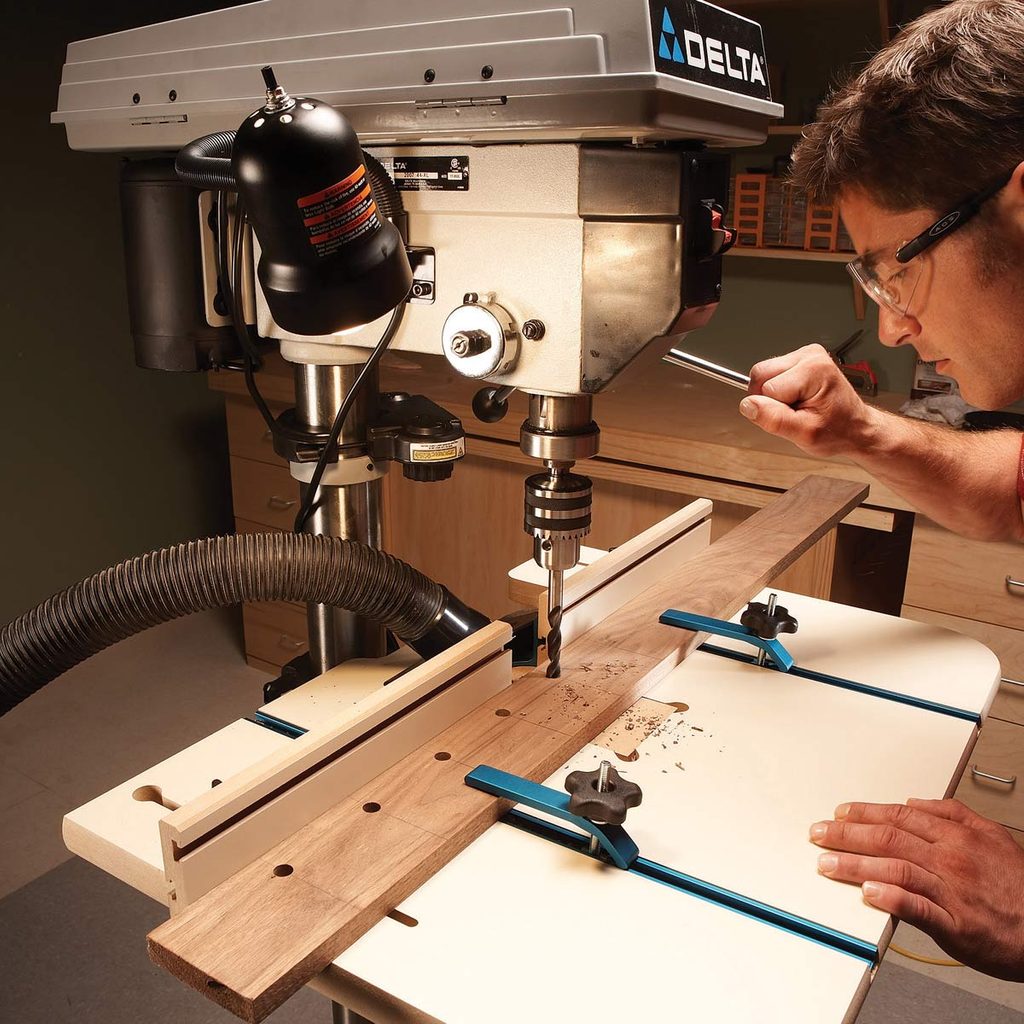Drill Press: What It Is and When Do You Use it?
Updated: Aug. 22, 2023

The drill press is a stationary or benchtop power tool designed to bore precise holes in wood or metal. Learn all about it here.
The drill press is a motorized tool designed to bore holes in wood, metal or plastic. Like a handheld drill, drill presses utilize various types of bits to make holes of different diameters. But unlike a handheld drill, drill presses are stationary or bench-top machines. If you need a drilling tool only for small home repairs and the occasional woodworking project, a drill press probably isn’t for you. But if you’d like to get serious about working with wood or metal, a drill press will make it easier to bore precise holes, countersink or counterbore those holes and use sanding attachments.
On This Page
How a Drill Press Works
A full-sized stationary drill press is heavy, relatively expensive and takes up valuable floor space in your work area. But what the drill press lacks in portability, it makes up for in power and precision. Unlike handheld drills which rely on arm strength and the steadiness of the operator to drill an accurate, clean hole, drill presses are precise by design. A rotating handle controls the descent of a spinning mechanism called the spindle (the bit is held in a chuck on the end of this spindle), which can only move vertically. This makes perfectly precise holes much easier to create. All models have a depth stop, for creating holes of consistent depth.
How to Choose a Drill Press
A drill press is a significant investment with some variables that you need to understand to purchase the right tool for you. Here are the main things to consider when shopping for a drill press.
Drill Press Type
There are two main types of drill presses: bench top and stationary models. Bench top models are smaller, lighter and more portable. Floor models are heavier and harder to move, but have more power, capacity and features.
Drill Press Size
All drill presses have two main size elements to consider: swing and spindle travel.
Swing is the distance between the machine’s central column and the spindle, multiplied by two. This determines the maximum width of material you can fit on your drill press, if you want to bore to the center of a workpiece.
Spindle travel boils down to how deep your drill press can move downward as you rotate the handle. Benchtop models might only allow two or three vertical inches of downward movement, while the best full-sized units, such as this well reviewed model from Delta, can move five or six inches.
Drill Press Power
The best way to judge the power of a drill press is by calculating watts. All models display amp and volt figures on the electrical name plate. Multiply these together and you get watts. The higher the wattage, the more powerful the tool and the tougher materials through which it will be able to bore.
The largest floor-model drill presses for home workshops deliver about 1,000 watts of power. Bench-top models typically have one-third to one-half this power.
Drill Press Speed
Most drill presses have variable rotation speeds for efficient drilling in different materials. Higher end models offer more speeds. Bench-top models typically offer five or six speeds, while a good floor model may have as many as 16. Why does rotation speed matter? The harder the material you’re drilling, the slower the drill bit speed you need.
Features
The table of a drill press is where the workpiece sits, and on nearly all models the table can move up and down to make room for your workpiece. Many models also allow side-to-side tilting of the table, either to 45 degrees or, for large, high-end models, a full 360 degrees, allowing drilling at all angles. Some models have LED lights or laser guides to show exactly where your hole will land.
Uses for a Drill Press
Want to build a coat rack? You’ll need a drill press to bore accurate holes for hanging pegs in the back board. Want to make some wooden toys? The twist bits, spade bits and hole saws used for this work perform much better and more accurately in a drill press. And when it comes time to sand the edges of those curved wooden toy parts, a sanding mop spinning in a drill press does a superb job. Need to hide some screws underneath wooden plugs? A drill press is the only tool capable of spinning a special bit that cuts tapered plugs from any kind of wood. Got metal parts to clean with a wire wheel? Building a stair railing? Boring big holes in wood for dowel joints? All of these tasks and more are made better with a drill press. It’s one of those tools you’ll use much more than you ever thought you would. While you’re at it, here’s what you need to know about horizontal boring.
